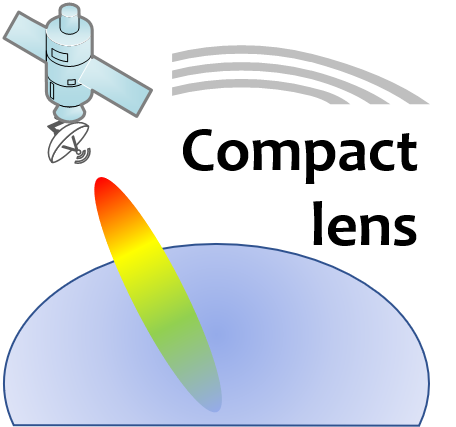
-
StatusCompleted
-
Status date2024-04-22
-
Activity Code7C.046
The objective of this project is to investigate lens antennas, and their ability to provide a cost-effective solution for Satcom on-the-move ground terminals. Lens antennas are associated with a high directivity, and beam scanning can be obtained by moving only the feed. Moreover, multiple simultaneous beams can be obtained in the same aperture by using multiple feeds displaced along the focal arc or surface. However, lenses suffer from a large physical size. In this project, we investigate different techniques for providing a more compact lens antenna solution, while maintaining the high-quality radiation characteristics of lens antennas. The goal is to develop antennas that can provide a high directivity and wide-angle steerable radiation patterns at a low cost and with a compact size.
Conventional lens antennas provide attractive properties in terms of directivity and scanning. However, the size of lens antennas is, for some applications, prohibitive. Related to this, there are two main challenges in this project:
- To reduce the height of the lens so that it is compliant with ground mobile environments. We investigate lens compression within the framework of transformation optics and other techniques.
- To retain the attractive properties of lens antennas after the size reduction.
Most available Satcom on-the-move systems are based on one of two solutions: reflectors or arrays. Associated with these solutions, there are some advantages and disadvantages. Reflector antennas are relatively cheap and can easily provide the high gain necessary, but they are hard to steer electronically, and slow purely mechanical steering of the full antenna system is often used. This may be sufficient on slow moving vehicles in communication with GEO stationary satellites but when one or both of the terminals (ground terminal or satellite) are moving fast (such as high-speed trains and LEO satellites), a faster scanning is needed. On the other hand, systems based on arrays can be made electronically reconfigurable, but they are very complex and expensive to manufacture at the high frequencies that are used in the LEO satellite constellations. The proposed solution consists of a lens that offers cost effective and sufficiently fast beam steering capabilities. Furthermore, the solution is cheap to manufacture with standard additive 3D printing.
The main objective of the project is to develop a cost-effective compact steerable directive antenna for satellite communications on-the-move. The main features of the proposed solution are:
- Highly directive, comparable to previously reported array and reflector solutions. To achieve a high directivity, a lens is employed.
- Wide angle beam steering capabilities with maintained radiation performance. This is obtained using a rotationally symmetric lens in the antenna.
- Reduced height of the antenna compared to conventional lenses. This height reduction is imperative for high-speed applications to reduce drag and simplify the integration with the platform.
- The beamforming for the Tx and Rx bands are integrated in the same aperture to ensure a high aperture efficiency for the developed system.
The lenses in the antennas can be manufactured with additive 3D printing, which results in a cost-effective manufacturing and allows for mass-production.
The antennas developed in this activity provide a mechanically steerable beam that require movement of only a small part of the system when steering. The beams can also be electronically switched if the feeding system of the developed antenna is modified. The architecture of the antenna is composed of two main parts.
- Gradient index lens, which provides the high gain. We develop the lens to be appropriate for manufacturing with 3D printing to ensure that the cost of the device is low. The height of the lens is compressed to ensure that the lens antenna does not protrude too much from its platform.
- Circularly polarized feeding that can be moved along the focal curve of the lens. The feeding system is designed to provide low axial ratio and a tapered illumination of the lens aperture so that the side lobe level is low.
The project is divided into four phases:
- Review of product requirements and available state-of-the-art.
- Study of different compression techniques and the applicability to the lens design. Different antenna solutions are proposed and verified in simulations.
- Validation of the most promising of the proposed designs. The designs are also compared to existing solutions in the literature.
- Link test using the antenna and a satellite in orbit.
The project is completed, and the concepts are experimentally verified in a lab environment and with initial tests in the real operational environment.




